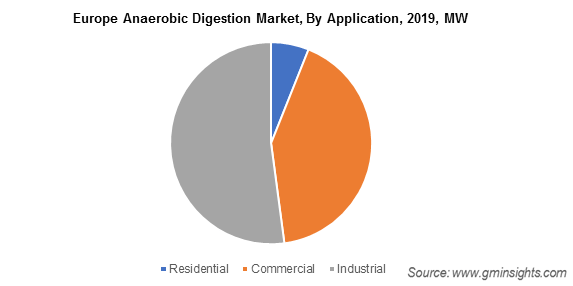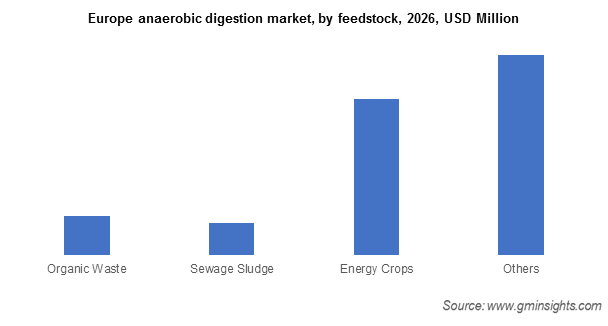Home > Energy & Power > Waste Management > Anaerobic Digestion > Europe Anaerobic Digestion Market
Europe Anaerobic Digestion Market Analysis
- Report ID: GMI2067
- Published Date: Feb 2020
- Report Format: PDF
Europe Anaerobic Digestion Market Analysis
The production of biogas, comprising methane, carbon dioxide and other gases, is a vital function of an anaerobic digestion plant. The proportion of methane produced is primarily determined by the type of feedstock used in the biogas plants. Organic waste, sewage sludge, energy crops, and other waste materials are primarily used as a raw material in AD plants.
Shifting trends toward the use of non-organic feedstocks for biogas production will stimulate the market demand of sewage sludge for generation of biogas.
Rising focus toward resource recovery technologies and expansion of wastewater treatment plants will significantly boost the adoption of sewage sludge as a fuel across the anaerobic digestion plants. Moreover, the ongoing shift to lower the overall disposing cost on account of their ability to reduce sewage sludge volume will further augment the Europe anaerobic digestion market trends.

Ongoing shift toward utilization of renewable energy resources is set to drive the biomethanization segment of the European market over the forecast timeline. For instance, in 2018, the EU introduced updated renewable energy directive with a target of 32% share of renewable energy resources (RES) in the final energy consumption by 2030.
The paradigm shift toward enhancing sustainability across key economic sectors coupled with the development of waste to energy framework across the region will fuel the Europe anaerobic digestion market outlook.
The management of municipal solid waste (MSW) has become a vital factor for the establishment of a circular economy. The growing demand of sustainable waste management practices is propelling the market growth of anaerobic digestion. Low-maintenance, cost effectiveness and minimal GHG emissions are some of the paramount features boosting the technology adoption across the commercial sector.
In addition, government supported programs are playing a key role in enhancing the market share of biogas generating technologies across the rural communities and areas without connection to grid.
Biogas is primarily produced from fermentation in anaerobic digesters using manure, agricultural waste, and energy crops. The anaerobic digestion plants can be divided into wet and dry, which is classified on the basis of moisture content of the feedstock. The wet digesters are more commonly used when compared to dry AD and consists of less than 15 percent of solid content.
The wet anaerobic digestion can produce more biogas per weight but have less tolerance for heavy metals and require more processing to separate materials. Reduced time for gas generation, larger gas output and higher content of methane are some of the prominent features which will drive the growth of wet section of the Europe anaerobic digestion market over the forecast timeframe.
Germany, Italy and Czech Republic collectively accounted for over 70% of market share in 2019. The reliability of the legal and political framework and effective support schemes will play a pivotal role in the expansion of Europe anaerobic digestion market trends. The developing regulatory framework pertaining to the GHG emission and adoption of renewable energy-based solutions will further favor the market statistics in the region.
In addition, high feedstock potential across Poland, Portugal, Belgium, Spain, Croatia and Ireland on account of their strong agricultural profiles along with availability of extensive gas supply and distribution networks will further enhance the market demand of anaerobic digestion over the forecast period.
Supportive regulatory schemes for the utilization of biogas primarily in electricity sector along with rising count of biogas fueled power plants will stimulate the Germany anaerobic digestion market. For instance, Renewable Energy Sources Act introduced in 2017, prioritizes the electricity generation from renewable energy sources.
Growing efforts to curb carbon footprint coupled with favorable government measures toward renewable energy adoption will further propel the market trends.

